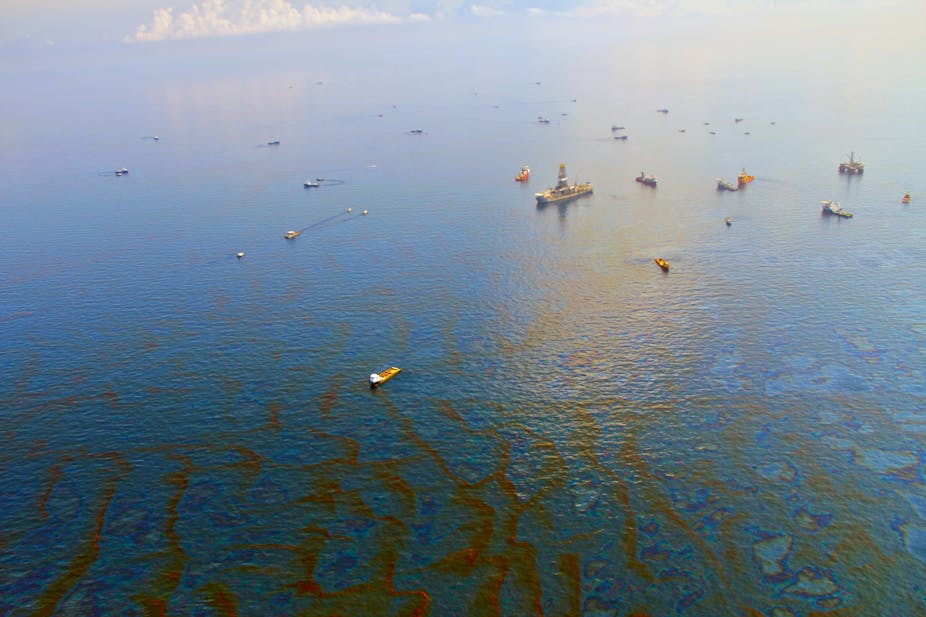Big oil companies are moving to exploit new, high-risk resources. This was most recently highlighted by concerns around BP’s exploration drilling in Australia’s Great Australian Bight and Shell’s plans to drill wells in the Arctic. But what’s driving the trend?
Environmentalists monitoring the energy markets will have noted three important developments in recent months.
First, the plunge in oil prices has triggered a string of bankruptcies, debt defaults and protectionist measures to rescue companies nearing collapse. The Financial Times reports that almost two-dozen companies are under stress and more than US$100 billion of spending on new projects has been “slowed, postponed or axed.”
Second, oil companies – including those who previously ploughed funds into climate denial – have sought to join the climate debate ahead of the Paris Climate Summit in December.
This follows shareholder resolutions from BP and Shell requiring greater transparency about the risks that climate change poses to their activities and the adoption by Exxon Mobil of an internal carbon price.
Finally, despite evidence that overall industry output will curb in the coming years, major players like OPEC have sought to increase their market share by maintaining production at low prices. Similarly, while energy majors have reduced capital spending (including a 50% cut in investment in Australia), many of those same players are exploring for oil in high-risk and environmentally sensitive areas.
While aspects of this story may appear inconsistent, I contend there is actually a logical thread – major players are responding to market conditions, securing their investments and positioning themselves ahead of competitors in order to expand their market share.
Energy companies may claim to be “leading the way” on environmental protection but they are venturing in to high-risk ecosystems to unlock resources which must remain stranded if we are to limit global warming to 2C.
BP in the Bight
The Great Australian Bight is a unique stretch of open bay that runs off the southern coastline of Australia. While a number of companies have been issued permits for offshore exploration, BP has advanced the furthest and is pushing for approval to drill in October 2016.
Bryan Ritchie, head of exploration for Asia-Pacific, has described Australia as a key player in BP’s global exploration program.
BP is currently appealing against damages from the Deepwater Horizon explosion of the Gulf of Mexico, which killed 11 workers and triggered the worst offshore oil spill in US history. In response, Louisiana District Judge Carl Barbier described BP as “grossly negligent” and “reckless”.
While important changes have been made since this disaster, analysts have argued that the oil industry has expanded its “technological horizon” in ways that make it “harder to foresee the complex interactions between drilling technologies, inevitable human errors and the ultra-deepwater environment”.
Compounding this risk, the Guardian published internal documents last week, which revealed that, in the event of a spill, BP would need to transport a “cap” from Singapore (4,800km/32 days) and a “containment response system” from Texas (14,000km/25 days).
The Bight exploration area is harsher and more remote and than the Gulf of Mexico – which despite being far closer to recovery equipment leaked 40,000 barrels a day for 87 days.
Moreover, the exploration area overlaps with the boundaries of the Great Australian Bight Commonwealth Marine Reserve and over an area that is currently being assessed as a marine park. Environmental groups have voiced concerns that even a small spill would devastate marine life, including a nursery for the southern right whale and major fisheries.
Shell in the Arctic
On the other side of the world, Shell is planning this July to drill two wells in the Chukchi Sea in the Arctic. Two things stand out.
First, access is only possible for two-three months in the summer, when increased temperatures melt the ice sufficiently for exploration to commence.
Second, both industry and environmental groups agree that “the Chukchi Sea is one of the most dangerous places in the world to drill”.
Shell has already spent more than US$7 billion securing its claim over competitors Statoil and Chevron who have delayed or cancelled exploration due to the plunge in oil prices. Shell was also forced to postpone exploration after a 2013 US Interior Department report, which found that the company failed in a range of “basic operational tasks”, and that management was “unprepared for the problems it encountered operating in the unforgiving Arctic environment”.
Despite the conditions and this history, Ann Pickard, Shell’s executive vice-president for the Arctic was quoted last week as saying: “This is not rocket science; we can do this.”
Glib remarkss of a similar nature have caused hundreds of protesters to occupy the Puget Sound in their kayaks and incited student activist Chiara D’Angelo to attach herself for three days to the anchor of the Royal Dutch Shell support ship Arctic Challenger.
Stranded assets
The idea of “stranded assets” is a sophisticated weapon in the armoury of the climate movement. It has already impacted investment worth US$2.5t. It will continue to gain momentum after Norway’s decision last week to examine if its US$840bn oil fund should cease investment in fossil fuel companies.
BP and Shell are both among the fund’s top 10 holdings.
Investors can no longer afford to view environmental sustainability as a fringe concern. Big oil is pushing into areas that are deeper, harsher and more remote than ever before. Professional investors may not have a fiduciary duty to protect the environment, but they have clear obligations to beneficiaries.
Investment in the Bight and the Arctic encourages a disorderly transition of capital and will result in significant financial losses if there is another major spill. This, coupled with regulatory efforts to combat climate change and the decline in renewable energy costs, will help campaigners make the case that big oil is an increasingly risky investment.

